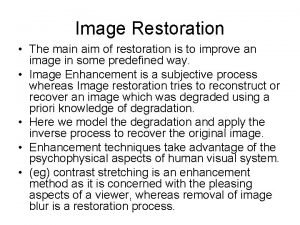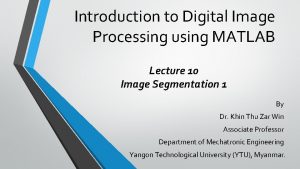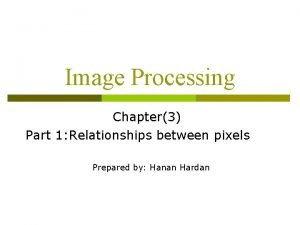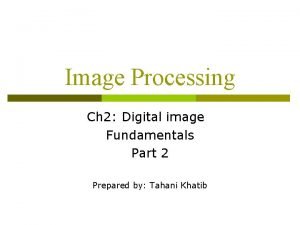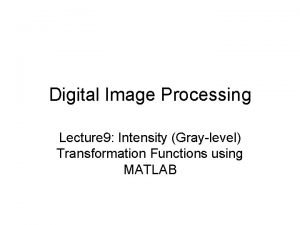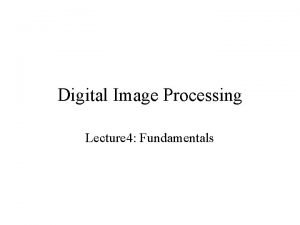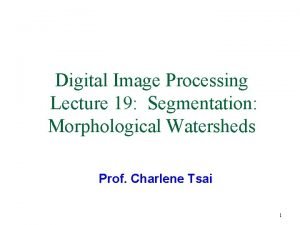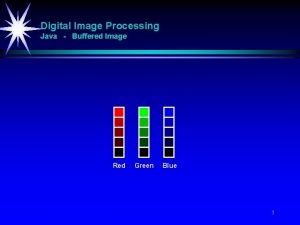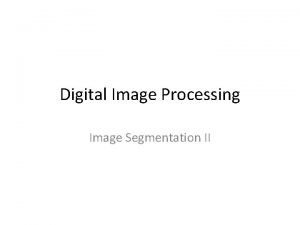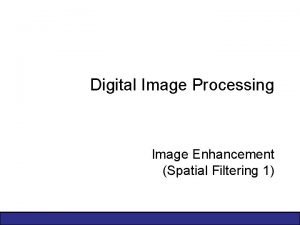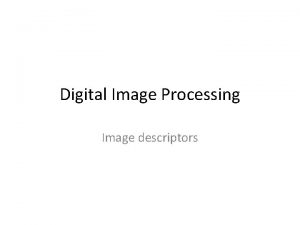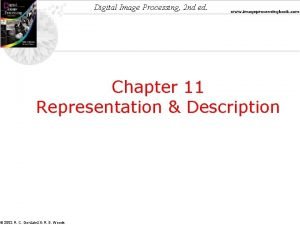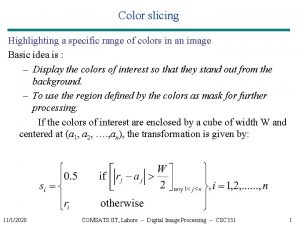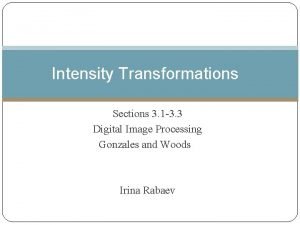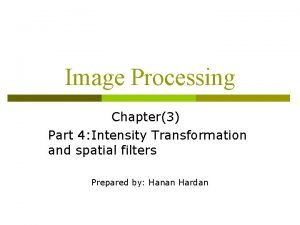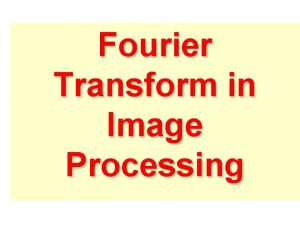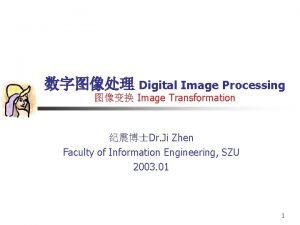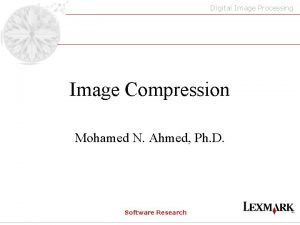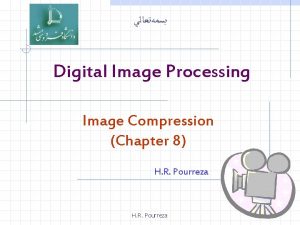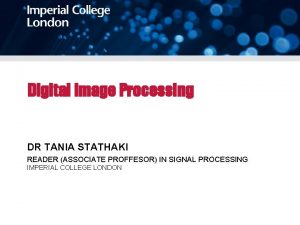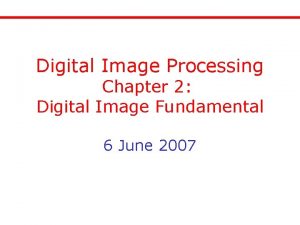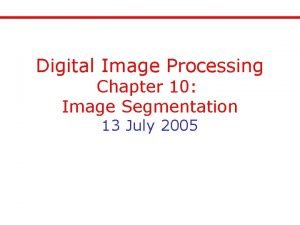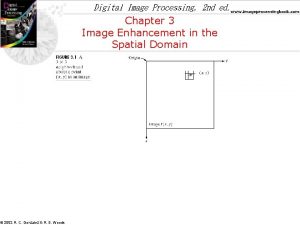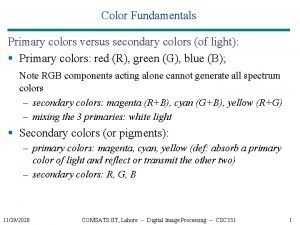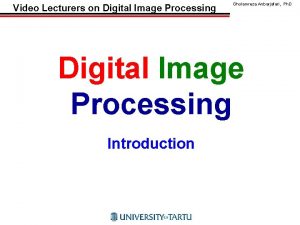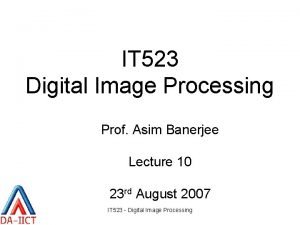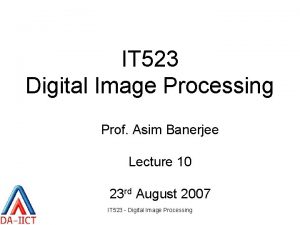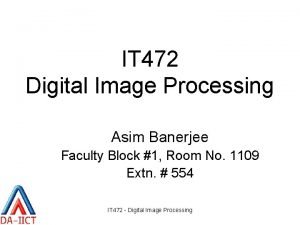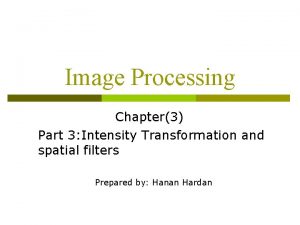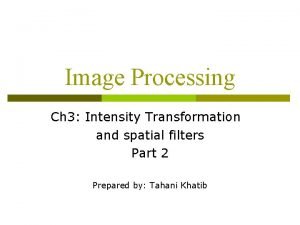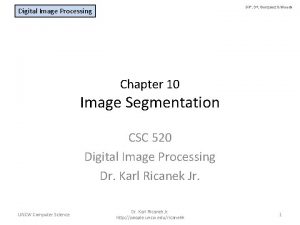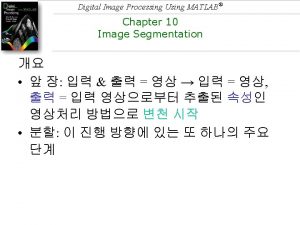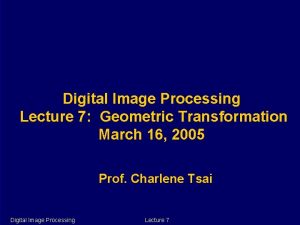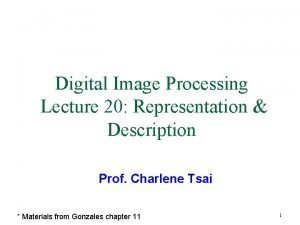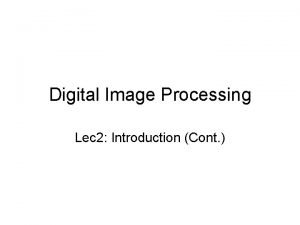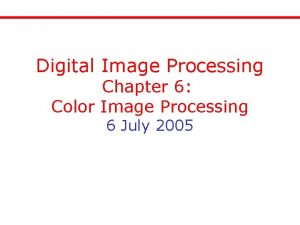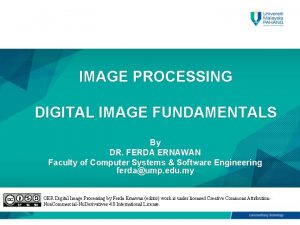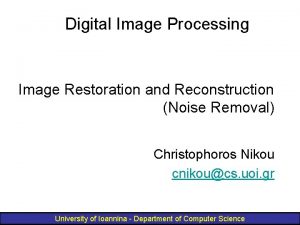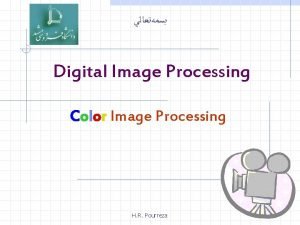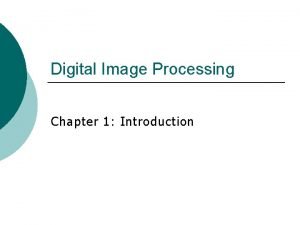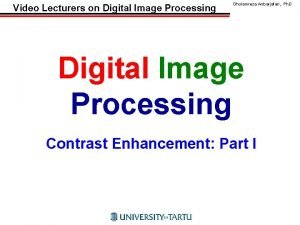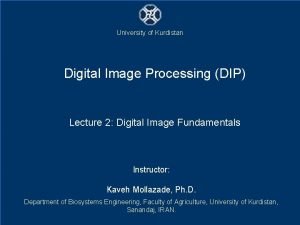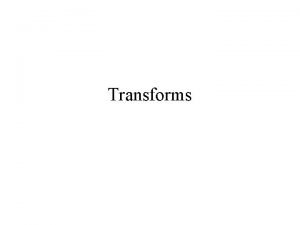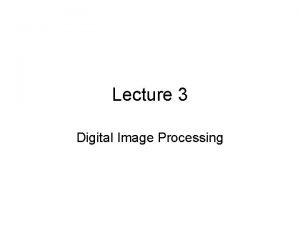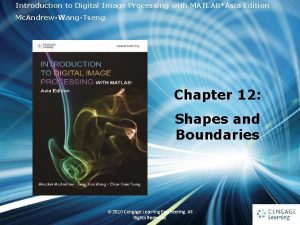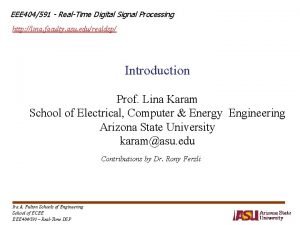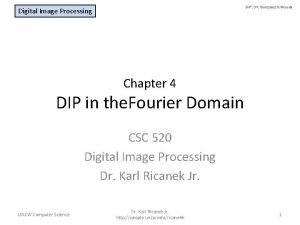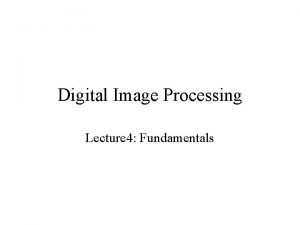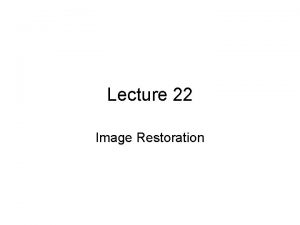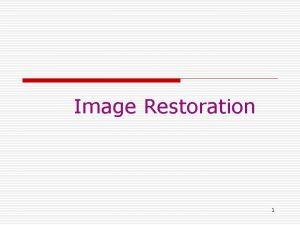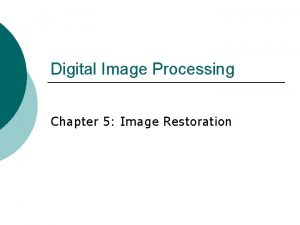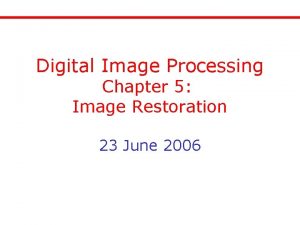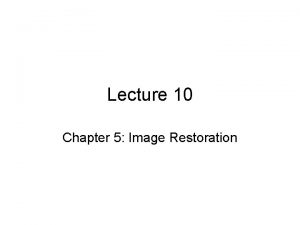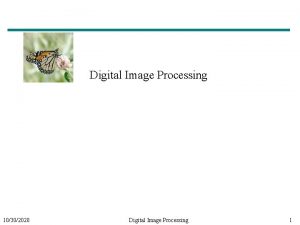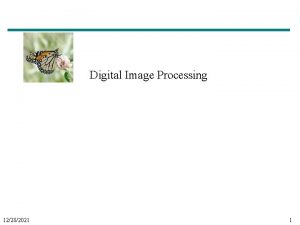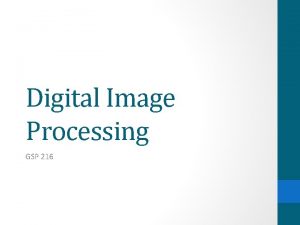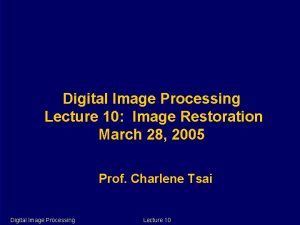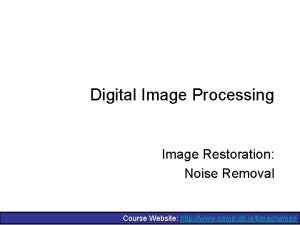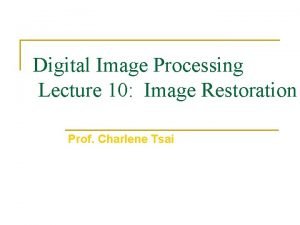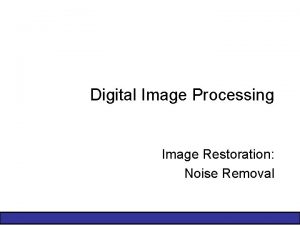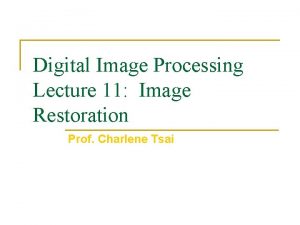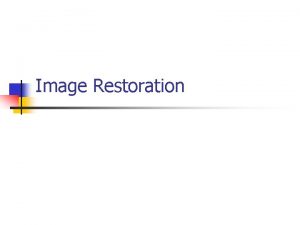Digital Image Processing Image Restoration Chapter 5 H












































































- Slides: 76

ﺑﺴﻤﻪﺗﻌﺎﻟﻲ Digital Image Processing Image Restoration (Chapter 5) H. R. Pourreza

Image Restoration • Image restoration vs. image enhancement n Enhancement: w largely a subjective process w Priori knowledge about the degradation is not a must (sometimes no degradation is involved) w Procedures are heuristic and take advantage of the psychophysical aspects of human visual system n Restoration: w more an objective process w Images are degraded w Tries to recover the images by using the knowledge about the degradation H. R. Pourreza

An Image Degradation Model • Two types of degradation n Additive noise w Spatial domain restoration (denoising) techniques are preferred n Image blur w Frequency domain methods are preferred • We model the degradation process by a degradation function h(x, y), an additive noise term, (x, y), as g(x, y)=h(x, y)*f(x, y)+ (x, y) n n n f(x, y) is the (input) image free from any degradation g(x, y) is the degraded image * is the convolution operator The goal is to obtain an estimate of f(x, y) according to the knowledge about the degradation function h and the additive noise In frequency domain: G(u, v)=H(u, v)F(u, v)+N(u, v) • Three cases are considered in this Chapter n n n g(x, y)=f(x, y)+ (x, y) (5 -2~5 -4) g(x, y)=h(x, y)*f(x, y) (5 -5~5 -6) g(x, y)=h(x, y)*f(x, y)+ (x, y) (5 -7~5 -9) H. R. Pourreza

A Model of the Image Degradation/Restoration Process H. R. Pourreza

Noise Model • We first consider the degradation due to noise only n h is an impulse for now ( H is a constant) • White noise n Autocorrelation function is an impulse function multiplied by a constant w w It means there is no correlation between any two pixels in the noise image w There is no way to predict the next noise value n The spectrum of the autocorrelation function is a constant (white) (the statement in page 222 about white noise is wrong) H. R. Pourreza

Gaussian Noise • Noise (image) can be classified according the distribution of the values of pixels (of the noise image) or its (normalized) histogram • Gaussian noise is characterized by two parameters, (mean) and σ2 (variance), by • 70% values of z fall in the range [( -σ), ( +σ)] • 95% values of z fall in the range [( -2σ), ( +2σ)] H. R. Pourreza

Gaussian Noise H. R. Pourreza

Other Noise Models • Rayleigh noise n n The mean and variance of this density are given by a and b can be obtained through mean and variance H. R. Pourreza

Other Noise Models • Erlang (Gamma) noise n n The mean and variance of this density are given by a and b can be obtained through mean and variance H. R. Pourreza

Other Noise Models • Exponential noise n n n The mean and variance of this density are given by Special case pf Erlang PDF with b=1 H. R. Pourreza

Other Noise Models • Uniform noise n n The mean and variance of this density are given by H. R. Pourreza

Other Noise Models • Impulse (salt-and-pepper) noise n n If either Pa or Pb is zero, the impulse noise is called unipolar a and b usually are extreme values because impulse corruption is usually large compared with the strength of the image signal It is the only type of noise that can be distinguished from others visually H. R. Pourreza

A Sample Image H. R. Pourreza

Effect of Adding Noise to Sample Image H. R. Pourreza

Effect of Adding Noise to Sample Image H. R. Pourreza

Periodic Noise • Arises typically from electrical or electromechanical interference during image acquisition • It can be observed by visual inspection both in the spatial domain and frequency domain • The only spatially dependent noise will be considered H. R. Pourreza

Estimation of Noise Parameters • Periodic noise n Parameters can be estimated by inspection of the spectrum • Noise PDFs n n n From sensor specifications If imaging sensors are available, capture a set of images of plain environments If only noisy images are available, parameters of the PDF involved can be estimated from small patches of constant regions of the noisy images H. R. Pourreza

H. R. Pourreza

Estimation of Noise Parameters • In most cases, only mean and variance are to be estimated n Others can be obtained from the estimated mean and variance • Assume a sub-image with plain scene is available and is denoted by S n n H. R. Pourreza

Restoration in the Presence of Noise Only (De-Noising) • Mean filters n Arithmetic mean filter w g(x, y) is the corrupted image w Sx, y is the mask n Geometric mean filters w Tends to preserve more details n Harmonic mean filter w Works well for salt noise but fails for pepper noise n Contraharmonic mean filter w w w Q: order of the filter Positive Q works for pepper noise Negative Q works for salt noise Q=0 arithmetic mean filter H. R. Pourreza Q=-1 harmonic mean filter

Corrupted by Gaussian Noise De-Noising Mean Filtering Geometric Mean Filtering H. R. Pourreza

De-Noising Corrupted by pepper noise 3 x 3 Contraharmonic Q=1. 5 Corrupted by salt noise 3 x 3 Contraharmonic Q=-1. 5 H. R. Pourreza

De-Noising H. R. Pourreza

Filters Based on Order Statistics (De-Noising) • Median filter n Median represents the 50 th percentile of a ranked set of numbers • Max and min filter n Max filter uses the 100 th percentile of a ranked set of numbers w Good for removing pepper noise n Min filter uses the 1 percentile of a ranked set of numbers w Good for removing salt noise • Midpoint filter n Works best for noise with symmetric PDF like Gaussian or uniform noise H. R. Pourreza

De-Noising Corrupted by salt & pepper noise One pass median filtering Three pass median filtering Two pass median filtering H. R. Pourreza

Corrupted by pepper noise Corrupted by salt noise De-Noising Max Filtering H. R. Pourreza Min Filtering

Alpha-Trimmed Mean Filter (De-Noising) • Alpha-trimmed mean filter takes the mean value of the pixels enclosed by an m×n mask after deleting the pixels with the d/2 lowest and the d/2 highest gray-level values n n gr(s, t) represent the remaining mn-d pixels It is useful in situations involving multiple types of noise like a combination of salt-and-pepper and Gaussian H. R. Pourreza

De-Noising Added salt & pepper noise Corrupted by additive Uniform noise 5 x 5 Mean Filtering 5 x 5 Geo-Mean Filtering 5 x 5 Median Filtering 5 x 5 Alphatrimmed Mean Filtering H. R. Pourreza

Adaptive Filters (De-Noising) • Adaptive Local Noise Reduction Filter n Assume the variance of the noise is either known or can be estimated satisfactorily Filtering operation changes at different regions of an image according to local variance calculated within an M×N region If , the filtering operation is defined as n If n n , the output takes the mean value w That is: n At edges, it is assumes that H. R. Pourreza

De-Noising Corrupted by Gaussian noise Mean Filtering Adaptive Filtering Geo-Mean Filtering H. R. Pourreza

Adaptive Median Filter (De-Noising) • Median filter is effective for removing salt-and -pepper noise n The density of the impulse noise can not be too large • Adaptive median filter n Notation w w w Zmin: minimum gray value in Sxy Zmax: maximum gray value in Sxy Zmed: median of gray levels in Sxy Zxy: gray value of the image at (x, y) Smax: maximum allowed size of Sxy H. R. Pourreza

Adaptive Median Filter (De-Noising) • Two levels of operations n Level A: Used to test whether Zmed is part of s-and-p noise. If yes, window size is increased Level B: Used to test whether Zxy is part of s-and-p noise. If yes, apply regular median filtering w A 1= Zmed –Zmin w A 2= Zmed –Zmax w If A 1 > 0 AND A 2 < 0, Go to level B else increase the window size by 2 w If window size <= Smax repeat level A else output Zxy n w B 1= Zxy –Zmin w B 2= Zxy –Zmax w If B 1 > 0 AND B 2 < 0, output Zxy else output Zmed H. R. Pourreza

De-Noising Median Filtering H. R. Pourreza Adaptive Median Filtering

Periodic Noise Reduction by Frequency Domain Filtering • Lowpass and highpass filters for image enhancement have been studied • Bandreject, bandpass, and notch filters as tools for periodic noise reduction or removal are to be studied in this section. H. R. Pourreza

Bandreject Filters • Bandreject filters remove or attenuate a band of frequencies about the origin of the Fourier transform. • Similar to those LPFs and HPFs studied, we can construct ideal, Butterworth, and Gaussian bandreject filters H. R. Pourreza

Bandreject Filters • Ideal bandreject filter H. R. Pourreza

Bandreject Filters • Butterworth bandreject filter n =1 H. R. Pourreza

Bandreject Filters • Gaussian bandreject filter H. R. Pourreza

Bandreject Filters H. R. Pourreza

Bandbass Filters Bandpass filter performs the opposite of a bandpass filter H. R. Pourreza

Notch Filters • Notch filter ejects frequencies in predefined neighborhoods about a center frequency. • It appears in symmetric pairs about the origin because the Fourier transform of a real valued image is symmetric. H. R. Pourreza

Notch Filters • Ideal notch filter H. R. Pourreza

Notch Filters n=2 • Butterworth notch filter H. R. Pourreza

Notch Filters • Gaussian notch filter H. R. Pourreza

Notch Filters Notch filters that pass, rather than suppress: • NR filters become highpass filters if • NP filters become lowpass filters if H. R. Pourreza

Notch Filters You can see the effect of scan lines Notch pass filter Spectrum of image IFT of NP filtered image Result of NR filter H. R. Pourreza

Optimum Notch Filtering H. R. Pourreza

Optimum Notch Filtering • In the ideal case, the original image can be restored if the noise can be estimated completely. n That is: • However, the noise can be only partially estimated. This means the restored image is not exact. n Which means H. R. Pourreza

Optimum Notch Filtering • In this section, we try to improve the restored image by introducing a modulation function n Here the modulation function is a constant within a neighborhood of size (2 a+1) by (2 b+1) about a point (x, y) We optimize its performance by minimizing the local variance of the restored image at the position (x, y) H. R. Pourreza

Optimum Notch Filtering Points on or near Edge of the image can be treated by considering partial neighborhoods Assumption: H. R. Pourreza

Optimum Notch Filtering To minimize H. R. Pourreza

Optimum Notch Filtering H. R. Pourreza

Optimum Notch Filtering H. R. Pourreza

Optimum Notch Filtering H. R. Pourreza

Optimum Notch Filtering Image size: 512 x 512 a=b=15 H. R. Pourreza

Linear, Position-Invariant Degradation • Degradation Model In the absence of additive noise: For scalar values of a and b, H is linear if: H is Position-Invariant if: H. R. Pourreza

Linear, Position-Invariant Degradation In the presence of additive noise: • Many types of degradation can be approximated by linear, position-invariant processes • Extensive tools of linear system theory are available • In this situation, restoration is image deconvolution H. R. Pourreza

Estimating the Degradation Function • Principal way to estimate the degradation function for use in image restoration: § § § Observation Experimentation Mathematical modeling H. R. Pourreza

Estimating by Image Observation • We look for a small section of the image that has strong signal content ( ) and then construct an un-degradation of thisonsection Now, we construct a function a large by scale, using sample gray shape. levels ( ). but having the same H. R. Pourreza

Estimating by Experimentation • We try to obtain impulse response of the degradation by imaging an impulse (small dot of light) using the system. Therefore H. R. Pourreza

Estimating by Modeling Atmospheric turbulence model: High turbulence k=0. 0025 Negligible turbulence Low turbulence k=0. 00025 Mid turbulence k=0. 001 H. R. Pourreza

Estimating by Modeling Blurring by linear motion: H. R. Pourreza

Estimating by Modeling H. R. Pourreza

Inverse Filtering The simplest approach to restoration is direct inverse filtering: Even if we know the degradation function, we cannot recover the undegraded image If the degradation has zero or very small values, then the ratio N/H could easily dominate our estimation of F. One approach to get around the zero or small-value problem is to limit the filter frequencies to value near the origin. H. R. Pourreza

Degraded Image Inverse Filtering with H cut off outside a radius of 40 Full inverse Filtering with H cut off outside a radius of 70 H. R. Pourreza Filtering with H cut off outside a radius of 85

Minimum Mean Square Error Filtering (Wiener Filtering) This approach incorporate both the degradation function and statistical characteristic of noise into the restoration process. Image and noise are random process The objective is to find an estimation for f such that minimized e 2 H. R. Pourreza

Minimum Mean Square Error Filtering (Wiener Filtering) If the noise is zero, then the Wiener Filter reduces to the inverse filter. H. R. Pourreza

Minimum Mean Square Error Filtering (Wiener Filtering) Unknown Constant H. R. Pourreza

Wiener Filtering Full inverse filtering Radially limited inverse filtering H. R. Pourreza Wiener filtering (K was chosen interactively)

Inverse filtering Wiener Filtering Reduced noise variance H. R. Pourreza Wiener filtering

Geometric Transformations • Unlike the techniques discussed so far, geometric transformations modify the spatial relationships between pixels in an image. Geometric transformation: RUBBER-SHEET TRANSFORMATION Basic Operations: 1. Spatial Transformation 2. Gray-level Interpolation H. R. Pourreza

Spatial Transformations H. R. Pourreza

Spatial Transformations H. R. Pourreza

Gray-level Interpolation H. R. Pourreza

Geometric Transformations H. R. Pourreza

Geometric Transformations H. R. Pourreza
 What is image restoration in digital image processing
What is image restoration in digital image processing Noise
Noise Histogram processing in digital image processing
Histogram processing in digital image processing Point processing operations
Point processing operations Neighborhood processing in digital image processing
Neighborhood processing in digital image processing Point processing
Point processing Fractal
Fractal Morphological dilation
Morphological dilation Translate
Translate Fundamentals of image compression
Fundamentals of image compression Image segmentation in digital image processing
Image segmentation in digital image processing Lossless image compression matlab source code
Lossless image compression matlab source code Image sharpening in digital image processing
Image sharpening in digital image processing Image geometry in digital image processing
Image geometry in digital image processing False contouring
False contouring Walsh transform in digital image processing
Walsh transform in digital image processing Image geometry in digital image processing
Image geometry in digital image processing Cameraman.tif
Cameraman.tif Explain various boundary descriptors
Explain various boundary descriptors Representation and description in digital image processing
Representation and description in digital image processing Segmentation in digital image processing
Segmentation in digital image processing Introduction to digital image processing
Introduction to digital image processing Adjacency in image processing examples
Adjacency in image processing examples Intensity transformation functions
Intensity transformation functions For coordinates p(2,3) the 4 neighbors of pixel p are
For coordinates p(2,3) the 4 neighbors of pixel p are Gray level transformation in digital image processing
Gray level transformation in digital image processing M adjacency in image processing
M adjacency in image processing Coordinate conventions in digital image processing
Coordinate conventions in digital image processing Dam construction in image processing
Dam construction in image processing Digital image processing java
Digital image processing java Thresholding in digital image processing
Thresholding in digital image processing Segmentation in digital image processing
Segmentation in digital image processing Digital image processing
Digital image processing Boundary descriptors in digital image processing
Boundary descriptors in digital image processing Optimum global thresholding using otsu's method
Optimum global thresholding using otsu's method What is boundary descriptors in digital image processing
What is boundary descriptors in digital image processing Colour slicing
Colour slicing Intensity level slicing
Intensity level slicing Types of spatial filtering in digital image processing
Types of spatial filtering in digital image processing A function
A function Image processing
Image processing Digital image processing
Digital image processing Haar transform for n=8
Haar transform for n=8 Digital image processing
Digital image processing Lossy compression in digital image processing
Lossy compression in digital image processing Digital image processing
Digital image processing What is mach band effect in digital image processing
What is mach band effect in digital image processing Filetype:ppt
Filetype:ppt Digital image processing
Digital image processing Color fundamentals in digital image processing
Color fundamentals in digital image processing Image processing
Image processing Digital path in image processing
Digital path in image processing Digital path in image processing
Digital path in image processing Lossless compression in digital image processing
Lossless compression in digital image processing Intensity slicing in image processing
Intensity slicing in image processing Intensity transformation in digital image processing
Intensity transformation in digital image processing Digital image processing
Digital image processing Matlab
Matlab Image processing lecture
Image processing lecture Representation and description in image processing
Representation and description in image processing Specialized image processing hardware
Specialized image processing hardware Intensity level resolution
Intensity level resolution Color complements in image processing
Color complements in image processing Spatial resolution in digital image processing
Spatial resolution in digital image processing Digital image processing
Digital image processing Histogram equalization example
Histogram equalization example Image processing
Image processing Image processing
Image processing Pattern and pattern classes in image processing
Pattern and pattern classes in image processing Raquel anido
Raquel anido Digital image processing
Digital image processing Hadamard transform in digital image processing
Hadamard transform in digital image processing Aliasing in image processing
Aliasing in image processing Shape numbers in digital image processing
Shape numbers in digital image processing Digital processing
Digital processing Dip
Dip Coordinate conventions in digital image processing
Coordinate conventions in digital image processing

















